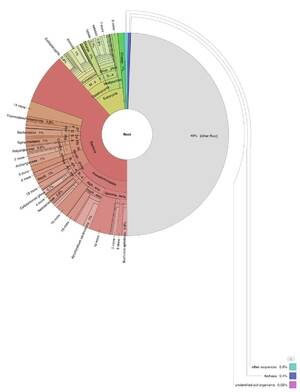DNA: Difference between revisions
(Added genomic analysis.) |
(Added picture.) |
||
| Line 1: | Line 1: | ||
[[File:3llaa8b7olsb1.jpg|thumb|right|Initial QC’d DNA Samples]] | |||
Seven samples were taken from the mummies: three tissue samples and four DNA samples. Only three samples were viable for further analysis: CEN4GEN-Ancient0002, CEN4GEN-Ancient003, and CEN4GEN-Ancient004. | Seven samples were taken from the mummies: three tissue samples and four DNA samples. Only three samples were viable for further analysis: CEN4GEN-Ancient0002, CEN4GEN-Ancient003, and CEN4GEN-Ancient004. | ||
Revision as of 09:00, 8 March 2024

Seven samples were taken from the mummies: three tissue samples and four DNA samples. Only three samples were viable for further analysis: CEN4GEN-Ancient0002, CEN4GEN-Ancient003, and CEN4GEN-Ancient004.
Ancient0002 had a fragment size of 398 base pairs, which, although not extensive, was sufficient to identify its species. Ancient0003 had 515 base pairs, and Ancient0004 had 423 base pairs, indicating relatively small DNA fragments.
The research team conducted thorough analyses, comparing the amplified sequenced DNA data against human DNA for quick verification to determine if any of the three viable samples were human. They selected a quarter fragment at random from each sequence and mapped it using the most current version of a human genome reference, specifically GRCH38 release 93.
The results revealed that Ancient0002 had 14.2924% human DNA content, Ancient0003 had 97.6894%, and Ancient0004 had 15.2589%. This means the percentage of the randomly selected quarter of DNA matched that many sequenced base pairs in the human genome reference used for comparison, suggesting Ancient0003 is likely human.
As a control, they applied the same process to DNA known to be 100% human, confirming Ancient003's results and verifying its human origin. Further testing showed Ancient003 matched human DNA with 95.07% accuracy and indicated a male origin due to the presence of X and Y chromosomes.
Ancient0004 and Ancient0002 underwent additional comparisons against a comprehensive database including various organisms like bacteria, viruses, fungi, and animals. Despite this, 27% of Ancient0002's and 90% of Ancient0004's DNA could not be matched to any DNA in the database.
Further refinement and comparison to a larger, more robust database (the NCBI nt database) yielded fascinating results: 54% of Ancient0002 and 76% of Ancient0004 were unclassified. However, this doesn't imply extraterrestrial origin; the DNA is terrestrial, and unclassified sections likely belong to unidentified microbes. Misinterpretations on platforms like Reddit, suggesting unclassified DNA means alien, are incorrect. The unclassified DNA shares similarities with known terrestrial organisms, indicating a need for more detailed study to fully understand these samples.